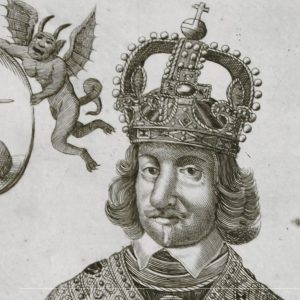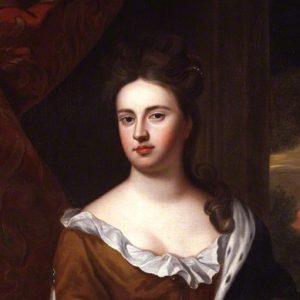Elizabeth
Elizabeth I (1533-1603) was born to Henry VIII (1491-1547) and his second wife, Anne Boleyn (1500-1536). Her mother was executed for treason in 1536, and, by the terms of the Second Succession Act (1536), Elizabeth was declared illegitimate, removing her from the line of succession. The Act was repealed in 1543 by the Third Succession Act, which returned Elizabeth to the line of succession after her protestant half-brother Edward (1537-1553) and her Catholic older half-sister Mary (1516-1558). The legislation was controversial. Technically Elizabeth remained a bastard, albeit one who could legally succeed to the crown. Elizabeth survived the political intrigues and religious persecution of the 1550s to claim the throne upon Mary’s death in 1558. She immediately re-established the protestant Church of England after Mary’s Catholic programme, and, with a new Act of Uniformity in 1559, imposed a Book of Common Prayer. As the future of the Tudor dynasty had been a major… Read more >>
James I
James VI and I (1566-1625) became king of Scotland, England, and Ireland. Born to Mary, Queen of Scots (1542-1587), and her second husband Henry Stewart, Lord Darnley (1545-1567), on 19 June 1566, James acceded to the Scottish throne upon his mother’s abdication in July 1567. He was crowned as a protestant, although his Catholic mother continued to cause trouble until her execution in 1587. In 1589 James married Princess Anne of Denmark (1574-1619), who was crowned Queen of Scotland at Holyrood Abbey on 17 May 1590. In 1594 the Stuart dynasty was strengthened by the birth of Prince Henry, and then secured by the births of Elizabeth in 1596, Margaret in 1598, Charles in 1600, and Robert in 1602, although Margaret and Robert sadly died in infancy. James’s great-great-grandparents were Henry VII of England and Elizabeth of York. He was the closest living relative of Queen Elizabeth of England (1533-1603). Hence, when Elizabeth died on 24 March 1603, James theoretically… Read more >>
Charles I
Charles I (1600-1649) was born to James VI of Scotland (1566-1625) and his wife, Anne of Denmark (1574-1619), on 19 November 1600. He was their third child, after Prince Henry (1594-1612) and Princess Elizabeth (1596-1662). In 1612 the militantly protestant Henry died suddenly from typhoid, sending shock waves through the court. Whereas Henry had been a promising heir, Charles was a sickly child and many thought it unlikely that he would survive to adulthood. Princess Elizabeth was promptly married to Elector Frederick V of Bohemia (1596-1632) in 1613. A foreign succession to the British throne seemed possible by their marriage. Nonetheless, Charles survived and cultivated his duties as the sole male heir, including patronage of the arts and participating in the elegant court masques of Ben Jonson and Inigo Jones. As war escalated in Europe, a protestant and Catholic union became increasingly necessary to establish peace. After a disastrous courtship of the Spanish Infanta Maria Anna… Read more >>
Oliver Cromwell
Oliver Cromwell (1599-1658) was Lord Protector of England, Scotland, and Ireland from 1653 to his death in 1658. Cromwell was born to Robert Cromwell (d. 1617) and Elizabeth Steward (d. 1654) in Huntington on 25 April 1599. In 1616 he attended Sidney Sussex College, Cambridge, and departed the college in 1617 after the death of his father. In 1620 Cromwell married Elizabeth Bourchier (1598-1665), bringing Cromwell into London’s wealthy merchant élite. They had nine children, including Cromwell’s son and heir, Richard (1626-1712). In the 1630s Cromwell lived a quiet life as a minor gentleman farmer. This decade saw his conversion to radical puritanism. In 1640 Cromwell was elected MP for the city of Cambridge. The circumstances of his election are unclear. He came to play a prominent role in parliament, sitting on multiple committees, pushing for religious reform. When, in July 1642, Charles I (1600-1649) begged the Cambridge colleges to loan him their wealth to pay his army… Read more >>
Charles II
Charles II (1630-1685) was born to Charles I (1600-1649) and Henrietta Maria (1609-1669) on 27 June 1630. He reigned from 1660 to his death in 1685. Charles spent most of the civil wars in Oxford with his father, leaving in 1645 to lead the royalist forces in the west country. In March 1646 Charles fled to the country, settling with his mother at the French palace of Saint-Germain near Paris. After his father’s execution in 1649, Charles was proclaimed King of Scotland by the Scottish parliament, and returned to Scotland to negotiate a settlement between the royalists and the Scottish presbyterians. He was crowned at Scone by the kirk on 1 January 1651. Late in 1650 Oliver Cromwell (1599-1658) led the English parliamentary forces north in the hope of occupying Scotland. Cut off from their northern supply lines by Cromwell, Charles led the army south to Worcester, where they were caught and defeated by Cromwell’s superior force. Charles famously escaped from the battle and Cromwell’s search… Read more >>
James Scott, Duke of Monmouth
James Scott (1649-1685) was the illegitimate son of Charles II (1630-1685) and Lucy Walter (1630?-1658), daughter of William Walter of Pembrokeshire. After Lucy began blackmailing Charles for annuity payments in 1657, Charles decided to have his son abducted and raised by his friend William, Lord Crofts (1611-1677), in Paris. In 1662 Charles summoned his son to England, where he joined the royal court at Whitehall. He quickly won his father’s affection. By the spring of 1663, James was married to a wealthy Scottish heiress and created Duke of Monmouth, among other honours and titles. After 1665, Monmouth enjoyed a prominent military career, serving in the navy under his Catholic uncle James, Duke of York (1633-1701), and, in 1672, commanding the army that assisted Louis XIV (1638-1715) against the Dutch. In 1678 he was appointed general of all the land forces in Britain. Charles’s fondness for Monmouth fuelled speculation that he would… Read more >>
James II
James II and VII (1633-1701) was born the third child and second son of Charles I (1600-1649) and his French consort Henrietta Maria (1609-1669). James spent much of his youth with his father at Oxford during the civil wars, before he was captured and taken prisoner to London. In April 1648 James escaped to the United Provinces and then to Saint-Germain, were he was reunited with his mother and brother Charles (1630-1685). James gained valuable experience as a tactician and solider after enlisting in the French army in 1652, experience that would prove useful while Lord High Admiral during the Anglo-Dutch wars of the 1660s and 1670s. He returned to England with his brother in May 1660, and married Anne Hyde (1637-1671) on 3 September 1660, after she became pregnant. Of their eight children, only two survived infancy: Mary (1662-1694) and Anne (1665-1714). But James also fathered many illegitimate children by numerous mistresses. At some point in the 1660s James secretly converted… Read more >>
William III
William III (1650-1702) was born to William II, Prince of Orange (1626-1650), and Mary Stuart (1631-1660), who was the daughter of Charles I of England (1600-1649) and sister to Charles II (1630-1685) and James II (1633-1701). A dedicated Calvinist, William devoted his life to curbing the influence over Europe of the Catholic power of France under Louis XIV (1638-1715). William was appointed stadtholder in 1672, and used both his position and his considerable skills as a solider and strategist to contain France during the wars of the 1670s. Anglo-Dutch relations were fraught throughout the 1660s and early 1670s, although they improved in 1677, when William married his cousin and James’s daughter, Mary (1662-1694). In 1680 William sided with the Whig faction that sought to exclude James from the line of succession. And from 1681 he remained in contact with leading Whigs such as William, Lord Russell, who was executed for treason in 1683. Charles II’s illegitimate Protestant son, James Scott… Read more >>
Mary II
Mary II (1662-1694) was born on 30 April 1662 to James, Duke of York (1633-1701) and his first wife, Anne Hyde (1637-1671). The deaths of her mother and infant brother Edgar (1667-1671) in 1671 made Mary the second in the line of succession, after her father. Mary’s marriage thus became crucial to the future of the British crown. Although Mary’s Catholic father was against the match, Charles II and his protestant counsellors pressed William of Orange (1650-1702), Mary’s first cousin and a militant protestant, as a suitable husband. The arrangements were finalized in the autumn of 1677, and Mary was informed, ex post facto, on 21 October. Mary miscarried two children in 1678 and 1679, and apparently never conceived again. This was a blow to the protestant succession of Britain. In Mary, the Stuart dynasty was at a dead end. Mary was devoutly protestant, and resisted James’s attempts to convert her to the church of Rome. Hence she supported her husband’s attempt to curb her… Read more >>
Anne
Anne (1665-1714) was born to James, Duke of York (1633-1701) and his first wife, Anne Hyde (1637-1671) on 6 February 1665. On 28 July 1683 Anne married Prince George of Denmark (1653-1708), as part of an Anglo-Danish alliance to curb the naval dominance of the Dutch. Because her sister, Mary (1662-1694) lived in Holland, Anne became the highest ranking protestant member of the royal family in England upon her father’s accession in 1685. As his plans for a revived Catholic state developed, Anne increasingly became the focus of protestant attention. In 1688 Anne perpetuated, or perhaps even invented, the rumours that the new born prince James Francis Edward (1688-1766) was spurious. Anne was aware of William’s planned coup before she left London on 25 July, and, on 25 November, escaped from Whitehall with her friend Sarah Churchill (1660-1744) and formally defected to William. Like Mary, Anne suffered obstetrical difficulties throughout her life. Of her seventeen… Read more >>
James Francis Edward Stuart
James Francis Edward Stuart (1688-1766) was born to James II (1633-1701) and his second wife, Mary of Modena (1658-1718) on 10 June 1688. His birth was a matter of national controversy. Mary had not conceived in five years, and James had no male heir to continue his Catholic programme in England. After his death, the throne would pass to his protestant daughter, Mary (1662-1694), and her protestant husband William of Orange (1650-1702). A male heir would supersede their claim. Hence, when James christened his new born son in the Catholic church, a Catholic succession to the British throne seemed likely, much to the chagrin of British protestants. A rumour promptly circulated—possibly started by Princess Anne (1665-1714)—that James Francis Edward was an illegitimate child. They claimed that he was a low born baby smuggled into the queen’s chamber in a bed warming pan. This was patently false. But, under the threat of a Williamite coup, James sent his Catholic son… Read more >>














